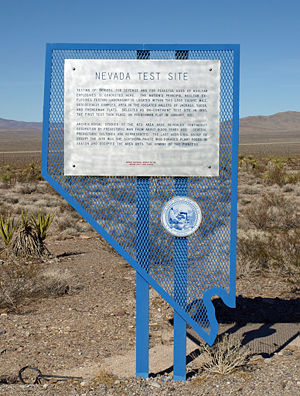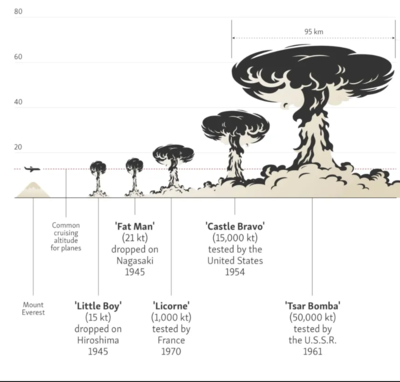Nuclear Weapon
 From Conservapedia
From Conservapedia Nuclear weapons usually have dramatically more destructive power than conventional weapon, where the power of a nuclear weapon is measured in kilotons. One kiloton has the equivalent explosive force of 1,000 tons of TNT.
Little Boy was the first of two atomic bombs ever used during warfare. It was developed by the United States during World War II, and was dropped on the Japanese city of Hiroshima on August 6, 1945. It had an explosive for of approximately 13 kilotons. Modern U.S. nuclear weapons such as the W88 warhead used on the Trident II missile, have a yield of 475 kilotons. Given the strength and size of the current US nuclear arsenal, the use of even a fraction of it would have devastating effects on the world's climate, probably rendering it unsuitable for human life.
Contents
Types of Nuclear Weapons[edit]
Fission Bombs[edit]
Fission bombs are characterized by a type of bomb where the nuclear force comes from a fission reaction. At its simplest, two sub-critical amounts of a fissile material are joined to form a critical mass which undergoes a spontaneous chain reaction. Bombs such as these usually use isotopes of uranium (uranium-235, uranium-233) or plutonium-239 as the fissile material.
Little Boy and Fat Man, developed and used in World War II by the United States are examples of fission bombs.
Fusion Bombs[edit]
Fusion bombs, also known as thermonuclear bombs, derive their energy from the fusion of atoms, usually either deuterium or tritium, which are isotopes of hydrogen. Fusion of hydrogen to helium is thought to be the process that causes our sun and stars to shine.
A thermonuclear detonation is typically started with the ignition of a compression fission bomb, which through a series of steps depending on the particular bomb design, produces temperatures and pressures high enough to ignite the fusion reaction of either the tritium or deuterium at the core of the bomb.
Dirty Bomb[edit]
- See also: Radiological dispersal device
A radiological dispersal device or dirty bomb is designed to spread radioactive material through the detonation with conventional explosives. A dirty bomb does not detonate its nuclear material during the explosion. A dirty bomb can be constructed with nuclear waste. It's often described as a "poor man's nuke."
The primary danger posed by a dirty bomb is the residual radioactive material contaminating the area around the blast site. The specific danger posed depends on the radioactive material used in the bomb, which can range from elevated levels of cancer to radiation poisoning. Even if the radioactivity is too low to be a serious danger, such a weapon could still induce fear in a population.
Dangerous isotopes with long half-lives are deposited on the surface of the earth, plants, and further into the ground and aquifers, making the area dangerous to live in for many decades. To a man to develop radiation sickness it is enough to get just one sievert dose (Sv), a dose of 3 to 5 Sv leads either to death in a couple of months or to the development of cancer, 6 to 10 Sv is a guaranteed death as the irreversible death of bone marrow begins.
Effects on the human body[edit]
During a nuclear explosion extremely dangerous isotopes are formed, including strontium-89, strontium-90, cesium-137, zinc-64 and tantalum-181. These isotopes, once in the body, accumulate there, causing severe and often incurable diseases. For example, radioactive iodine accumulates in the thyroid gland, cesium in muscles, strontium in bones and so on.
Nuclear States[edit]
The following countries are known to possess nuclear weapons:
The following countries are known to have once had nuclear weapons:
- South Africa (dismantled stockpile in 1990's)
- Belarus
- Ukraine
- Kazakhstan
Many other countries have at one time had an active nuclear weapons development program, but most have officially stopped research into nuclear weapons. Although a country may have the technology for nuclear power, it may not have the capability to produce nuclear weapons, which would require the ability to enrich uranium.
See also[edit]
- Nuclear target structures
- Biological weapon
- Chemical weapon
- Weapons of mass destruction
- Nuclear weapons accidents
- Self-defense
- First strike
- Balance of terror
- Mutually assured destruction
- Deterrence theory
- Post Apocalyptic World
- War
- List of military strategies and concepts
- Threats
- Terrorism
References[edit]
External links[edit]
Categories: [Nuclear Defense] [Weapons] [War] [Military History] [Military] [Diplomacy] [Cold War] [Military Strategies and Concepts] [Threats]
↧ Download as ZWI file | Last modified: 03/08/2023 06:33:31 | 12 views
☰ Source: https://www.conservapedia.com/Nuclear_weapon | License: CC BY-SA 3.0
 ZWI signed:
ZWI signed:

 KSF
KSF